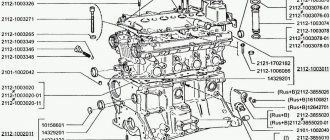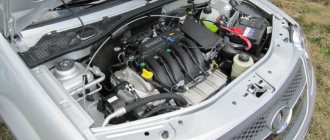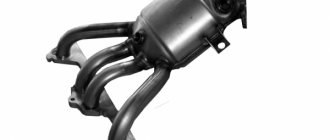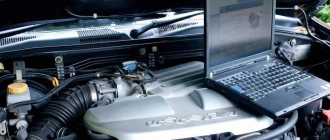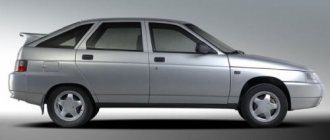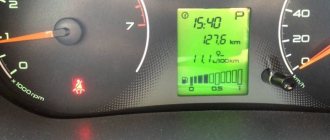One of the questions that interests novice drivers is the functional features of such a part as a catalyst. Why is this element needed in the car, what problems can arise with it and how to solve them? A catalyst (catalytic converter) is one of the elements of a car’s exhaust system; it reduces the proportion of toxic substances in the exhaust.
The gas that comes out of the exhaust pipe contains hundreds of dangerous compounds, including CO2 - carbon dioxide, NO, NO2 - compounds of nitrogen with oxygen, CH - hydrocarbon, etc. They have a detrimental effect on human health, a great deal the concentration of these poisons in the air can lead to the emergence of dangerous diseases. The Lada Kalina catalyst contains noble metals. With their help, toxic elements break down into substances that are safe for humans.
The operating time of the catalyst is on average 100,000 kilometers, but its breakdown can occur even earlier. The reason for this may be malfunction of the starter, low-quality gasoline, or damage to the integrity of the part due to driving on an uneven road.
Why do you need to replace the catalyst on a Kalina car with an 8-valve engine: causes and consequences
- Use of fuel additives.
- Unsatisfactory fuel quality.
- Unbalanced fuel-air mixture due to a broken oxygen sensor.
- Mechanical damage to the collector.
- Incorrect ignition operation.
For the most part, replacing the catalyst on Kalina 8 valves is done as a result of using low quality fuel.
Its slow combustion occurs partly in the exhaust. The detonation of gasoline destroys the ceramic structure of the honeycomb, which over time begins to crumble and clog thin passages. The engine begins to overheat and loses traction. An obstacle to the free passage of gases contributes to an increase in their pressure. When the internal combustion engine is turned off, in any case, the valve gas distribution system remains open in one of the cylinders. The excess pressure that should have escaped into the exhaust pipe throws ceramic particles back into the combustion chamber. At the next start, the dust will mix with the oil and turn into an abrasive paste, which can lead to complete failure of the internal combustion engine.
What you need to know
Before replacing a faulty Kalina car catalyst with 8 valves, you need to decide on the vehicle’s toxicity standards - Euro 2 or higher. On VAZ models, this is not difficult to find out - in the Euro 2 system, the oxygen controller is installed before the catalytic collector. Starting from the third generation of environmental standards, the diagnostic probe is also located after the neutralizer. It signals the efficiency of the device.
Since 2008, all VAZ cars meet Euro 3 standards and have two oxygen controllers. Before getting rid of the neutralizer, you need to consider some details:
- The unit is made with the exhaust manifold as a single unit.
- All sorts of solutions that boil down to removing the insides of the catalytic collector not only lead to a deterioration in acoustic comfort. Moreover, an empty housing creates an exhaust section with a large cross-section, which will lead to resonance of the exhaust system. So everything is in favor of using insertion.
- In the case of Euro 2, when installing the spider, an oxygen sensor wire extension is required, and the resonator-manifold connection unit must also be redone.
- In the case of Euro 3, a fake or the program in the ECU is changed.
Replacing the catalyst with a “spider”
Lada Kalina cars of both the first and second generation are equipped at the factory with a collector-type catalytic converter-neutralizer. It is made in the same housing with the receiving manifold. Depending on the environmental class of the car (“Euro-2” or “Euro-3”) it has one or two oxygen sensors. When the catalyst fails, there is a need to replace it.
Read also: What wires go to the battery
If the message “Check” appears on the information panel, the first thing you need to do is conduct computer diagnostics of the electronic control unit. With its help, you can determine whether the problem is really a malfunction of the car's filtration system or whether there is another breakdown. When the program confirms a malfunction of the catalyst, it is necessary to replace it - the part cannot be repaired. Most often, car enthusiasts prefer the option that involves installing a “spider” instead of a broken catalyst.
Technical features of the insert for Lada Kalina 8V
The industry offers two types of tuning inserts, the design of each of them depends on the location of the pipes. Moreover, each design is designed for a specific power unit:
- Insert 4-1 is installed on forced engines with a speed range from 5,000 to 10,000 rpm. structurally suitable only for 16-valve engines.
- The 4-2-1 insert operates over a wider range and is considered a "low-end" insert. It is possible to increase engine power by about 3-5%. This is the model most often installed on the VAZ 1118.
Since it will not be possible to install a preliminary flame arrester , you will have to carefully approach the issue of choosing an insert. The installation process of the part will not take much time if you follow all the recommendations.
Technology for changing the catalytic converter to the 4-2-1 insert
To work, you need to prepare a set of keys for 13, 17, 19 and 22, you also need a socket head for 13 and a screwdriver with a flat blade. Parts you should purchase are two bolts with springs, a graphite connecting ring, an extension for the sensor, and a manifold gasket. Since the spider with tubes is longer than the standard neutralizer, it would not hurt to purchase a corrugation with double or triple braiding 200 mm long.
You must first remove the negative terminal from the battery. The further process of dismantling the standard part continues according to the following diagram:
- Remove the intake module using a 13mm socket, disconnect the injector wiring harness and the fuel supply hose.
- Unscrew the nuts securing the flanges of the intake pipe and catalytic converter, and then remove the pipe flange from the converter studs.
- Disconnect the oxygen sensor connectors and disconnect the wiring harness from the heat insulation shield.
- Unscrew the two nuts securing the catalytic converter bracket and remove the clamp.
To finally replace the standard catalyst on Kalina 8 valves with a modified spider, all that remains is to slide the flange off the studs and pull the assembly down. The head gasket seating areas should be cleaned. The flange is cut off from the old catenary collector with a grinder and welded to a section of the pipe with corrugation. A snag is screwed into the sensor hole or the ECU is subsequently reflashed. These measures will get rid of the Check-Engine, and will also be cheaper than buying a new converter.
The insert is carefully inserted from above and placed on the cylinder head studs, after which the procedure for assembling the entire exhaust system is carried out. Corrugation can be excluded from the design, but its absence will significantly affect the vibration climate of the car.
Installing a spider in a 16-valve car
The sixteen-valve Kalina is equipped with a complex power supply and gas distribution system, so the work carried out will be more labor-intensive. The sequence of actions is as follows:
- removing the terminals from the battery, draining the coolant;
- loosening the clamps securing the air duct pipe and the throttle assembly to the filter;
- the pipe is removed;
- the chip is disconnected from the throttle assembly and oxygen sensor;
- the hose of the crankcase ventilation system is removed;
- the adsorber purge hose is disconnected;
- the receiver mounting bracket is unscrewed;
- the nuts are unscrewed and the receiver is removed;
- unscrew the upper and lower fastening nuts, remove the heat-insulating shield and eye;
- the fastenings of the spacer to the exhaust manifold are twisted;
- the heat shield is removed;
- the intake manifold is dismantled, for which you need to unscrew nine nuts near the block head and three at the exhaust pipe;
- “spider” is mounted;
- the lambda probe wire is extended, a mechanical or electronic snag is installed;
- The elements are assembled in the reverse order.
Replacing a catalyst is a rather complicated process. Inattention during operation can lead to damage to the vehicle's exhaust system and engine wear. Repairs should only be started if you have all the tools and replacement parts.
The catalyst prevents atmospheric pollution with carbon monoxide and other toxic substances. Its service life is not designed for more than 100,000 kilometers of vehicle mileage, so every owner will sooner or later be faced with the need to replace this element. You can replace the catalyst yourself or by contacting a service station. It is important to remember that inept DIY repairs will worsen the problem and cause additional costs in the future.
Summary
According to some motorists, after tuning the car becomes faster, there is no hysterical roar when the revolutions approach 5,000. The exhaust sound has also changed, it has become more pleasant. In most cases, there is a decrease in fuel consumption. The financial component is also very noticeable - installing a 4-2-1 spider costs at least half as much.
LADA Kalina has been produced since 2003, when the first copies rolled off the assembly line. Before this, prototypes of future production models were repeatedly tested.
Removing and replacing the catalyst on Kalina 8 valves
Replacing the catalyst on Kalina 8 valves involves work both in the engine compartment and under the bottom of the car.
- Initially, we provide ourselves with access to the exhaust manifold housing, move the high-voltage wires to the sides, and remove the plastic cover covering the motor at the top. Our collector itself is located at the front of the engine, if you look at it while standing in front of the car. When carrying out dismantling work, there is no need to drain the coolant.
- Using socket wrenches, unscrew the fastenings of the catalyst body. We do not remove it from its seat.
- At this stage, the work in the engine compartment is completed; it is necessary to lift the car on an electric lift for further dismantling.
- We need to unscrew the flange connections at the junction of the corrugated pipe and the back of the catalyst.
- Carry out a similar procedure in the resonator area.
- Now, piece by piece, remove the products from under the car and place them on the work surface for repairs.
Replacing the Lada Kalina catalyst begins with the fact that the owner of the technical device needs to decide on the further choice of part: a new standard catalyst or a “spider”. Considering the short lifespan of factory equipment, the second option would be the most practical. The catalyst is also often replaced with a flame arrester; Kalina accepts this alternative well. But in this article we will not consider this issue.
Tuning: replacing the catalyst on Kalina 8 valves with a 4-2-1 insert
When you need to replace the catalyst on a Kalina with an 8-valve engine, how to change it to a 4-2-1 spider insert and the main stages of the process.
In a car exhaust system, a catalytic converter is needed to burn harmful elements in the exhaust gases to the level of H2O and CO2. It is quite difficult to predict its service life, since it depends on many factors. But many owners of VAZ cars prefer to get rid of the collector before the end of its service life. For these purposes, they use special inserts, which are an inexpensive alternative to a neutralizer. Further more…
Join the group and you will be able to view images in full size
“Kalina” is a symbol of the domestic automobile industry, of course we are talking about a car. In 2004, the first copy rolled off the assembly line. Until 2013, the car was not subject to changes or restyling. Everything was the same, no improvements. Few people paid attention to the model and preferred foreign options. But after 2014, everything changed dramatically. The exterior and interior have changed significantly; The designers took into account the clients' comments.
The machine is manufactured in various variations. The engine is equipped with a direct injection system and electronic ignition. The body structure strictly complies with basic safety standards. Maneuverability has been increased by shortening the overall body length. Since the beginning of 2012, all Kalina models have been equipped with an electronic gas accelerator pedal.
Among the bulk of frequent breakdowns and shortcomings, many owners experience difficulties when the standard catalytic filler fails. Using the example of a Lada Kalina with an 8-valve engine, we will consider the algorithm for removing and replacing the seal.
Replacing the catalyst on Kalina: what do you need to know about the spider?
Let's look at how the Kalina car, replacing the catalyst and a device called a “spider” are connected below.
Many owners of technical equipment often complain that the stock version of the engine, tuned for Euro 3 firmware, by default “eats” 10-12% of the total power of the power unit. Part of the power is taken away by the exhaust gas removal system. This is not to the liking of many owners. You can restore justice by returning the required 10% of power by installing the so-called “spider” - a modified version of the exhaust manifold.
The design provides for a separate system of exhaust gases from each cylinder when exiting the combustion chamber. Thanks to this shape, each cylinder is better ventilated due to pressure differences in the exhaust system. To achieve the desired effect, it is necessary to use metal pipes of the required length. The pipes themselves are attached to the cylinder head and are installed according to the strokes of the engine.
Replacing the Lada Kalina catalyst: reasons for replacement
The most common reason that entails the installation of a spider instead of a catalyst is clogging of the honeycomb of the base of the catalytic element, both by fuel combustion products and by exfoliating particles of the base itself.
Natural degradation is normal. The catalyst, under favorable operating conditions, is designed for a service life of about 100 thousand kilometers.
Let's take a closer look at the moments when replacing the catalyst on a Lada Kalina car becomes necessary.
There are a number of factors that can significantly accelerate the destruction of the device:
- Problems with the formation of the correct fuel-air mixture. Both rich and lean mixtures have a negative effect here. A rich mixture leads to incomplete combustion of hydrocarbons and their deposition on the walls of the base cells. A lean mixture causes an abundance of oxygen in the exhaust gases, which has an oxidizing effect on the body at high temperatures. Also, due to an insufficient amount of fuel in the cylinder, misfires occur and unburned fuel is released into the catalyst. It can ignite while already in the manifold with the next portion of hot exhaust gases.
- Incorrect ignition timing. The fuel-air mixture is ignited at the wrong time. This leads to improper combustion and the formation of additional thermal loads on the catalyst.
- Gasoline is of poor quality. Gasoline saturated with impurities, after combustion, leaves soot deposits on the walls of the cells. In this case, rapid clogging of the catalytic element occurs.
- Coolant or oil getting into the cylinders. A leak in the lubrication and cooling systems leads to unauthorized penetration of working fluids into the combustion chamber. When they are burned, compounds are formed that lead to clogging or destruction of the catalyst.
In addition to the breakdown of the catalytic element itself, the housing itself often fails due to design flaws. The weld at the junction of the pipes of the first and fourth cylinders with the catalyst body is often destroyed. The escaping exhaust gases create increased noise. Exhaust also penetrates the interior, causing discomfort.
Read also: Barrels for transporting gasoline
A failed catalyst increases the load on the engine, as it creates resistance to the passage of exhaust gases. This may manifest itself in the following symptoms:
- increased fuel consumption;
- reduction in engine power;
- failures when trying to accelerate sharply;
- reduction in maximum speed;
- problems with starting.
Replacing the Lada Kalina catalyst: types of spiders
The Lada Kalina catalyst is replaced with one of two spider options: 4/1 and 4/2/1. The main difference between these options is that the first option involves attaching four pipes to one main pipe, which is supplied to the catalyst. The second option is somewhat modernized and provides the possibility of connecting four pipes into two, then into one. Both versions of the spider have no filling inside, only a solid cavity. In a standard catalyst, the specified filling allows the engine to comply with Euro 3 standards and higher, but at the same time, the filling suffocates the engine, taking away power.
Replacing the catalyst on Kalina 16 valves with a 4-1 spider system is the most ideal option. Power characteristics allow this to be done.
Depending on the type of spider, it is necessary to select the technical characteristics of the motor. It should be high-speed and forced. To ensure normal purging of the cylinders, more than 6500 rpm is required.
Replacing the catalyst with a spider on Kalina with an 8-valve system is carried out subject to the installation of a 4-2-1 type product. This design allows you to achieve maximum effect even at medium speeds. For this, no modifications to the Kalina power unit are needed, as in the version with a 16-valve mechanism.
Sequence of work in the 8-valve Kalina
The first step is to fill all threaded connections with liquid wrench. When exposed to high temperatures for a long time, nuts become deformed and destroyed due to corrosion, so unscrewing them is quite problematic. After tightening the nuts, the following work is carried out:
- the coolant is drained;
- lambda probe chips are removed;
- unscrew the bolts that secure the intake manifold to the cylinder head and exhaust pipe;
- the holding bracket is dismantled;
- the exhaust manifold is removed;
- the lambda probe wire is extended;
- “spider” is installed;
- the system is assembled in reverse order.
There are different spider options: 4-1 system; 4-2-1; 4-2-1 with modified sound. The most popular is 4-1. The design has four pipes converging into one, which are welded to the cylinder head plate. The 4-2-1 system is also made of four pipes, the first and second of which converge into one, as well as the third and fourth. The two pipes then form one and transmit the exhaust gases further into the system.
When installing the 4-2-1 spider, the exhaust pipe is shortened. As a result, it will be impossible to install a 4-1 design blende or a new catalyst into the car without modification. The 4-1 system is completely identical to the Kalina factory catalyst.
Lada Kalina: catalyst replacement - final stages
The final phase of installing the spider on the Lada Kalina occurs as follows:
- We weld the standard mount for the oxygen sensor onto the spider.
- We install the new spider in its regular place and start it through the opening in the lower part of the engine.
- Next, the system is assembled from a corrugated intake pipe. We cut out the length we need in order to connect the spider and the resonator together. If you plan to completely replace the system, then forward flow will follow, without the remaining parts of the exhaust system.
- We connect the flange connections to each other.
- We connect the lambda probe with long wires to connect to the ECU.
We lower the car, screw on the manifold housing, and start the engine.
The final stage: we rewrite the data in the engine ECU about the firmware version. This will allow the computer to understand the new exhaust system as stock. There will be no error identification on the instrument panel.
Often my blog (and my channel) receives a lot of questions regarding the catalyst, and some readers still have many misconceptions in their heads. One of them (for example) is that if you remove this part of the muffler, then it will be VERY bad for the car, it will literally stand up and refuse to go! I decided to answer all the questions at once, so today we will talk: - is it worth removing it or not (what are the pros and cons of such manipulation), what will be the consumption after cutting it out, is it necessary to flash the ECU (and what are the risks), and well a few words about “deception”. In general, it will be interesting, as usual, the video version at the end...
At the very beginning, I would like to say that this unit is NOT SOMETHING IMPORTANT for the car, but now “a bunch of stones” will fly at me, they say, what are you saying, but what about ECOLOGY? But if we put aside all the exclamations of the “greens”, then a car without a catalyst will work BETTER, CONSUMPTION will be lower, and the POWER will increase a little.
Recommendations
Comments 68
with eight valves the spider is of little use. take a regular insert, tested from personal experience
I unscrewed the catalytic converter, cut off the ears with a grinder and welded them to a simple pipe made of stainless steel exhaust drain, only everything was empty! I didn’t worry about the firmware and it didn’t catch fire! True, I had a catalytic converter after the spider
You can use a snag But it’s better to flash it under Euro-2
Order a spider for two oxygen sensors! We can do that. The second one will be through a mechanical fuse right away (a sleeve like this goes under the second one). And don't forget to order two oxygen sensor extensions. If you have any more questions, I will answer in PM.
flashing in any case, the difference will be noticeable, don’t worry, I’m telling you as a diagnostician
Good evening, Alexander. I ask for advice as a diagnostician. I have a viburnum 8 class, 1.6, EURO-2. Three years ago, instead of the catalytic collector, I installed a dummy and after that, periodically, one might even say, the error “no DC activity” began to light up periodically, I installed a new oxygen sensor, everything is the same. Do I need to reflash it for Euro-0?
It is possible under Euro-0, but the consumption will be slightly higher. It’s better to flash it under Euro-2 or edit your own, or better yet, online firmware!
Read also: Oil leaking from ignition coil
It’s easier to install an insert to replace the 4-1 catalyst, there’s no need for any screws, everything is done right for the second sensor, but the first one needs to be extended anyway.
why install a spider? want to achieve an increase in power?
no, I just want to throw away the catalyst to hell and install a stainless steel spider
why install a spider? want to achieve an increase in power?
no, you need durability
Then I don’t see the point in a spider, to be honest)) set the factory and the jacks won’t light up and it will drive as it did)
thanks, we'll do that
sewing of course! otherwise what's the point!)
the spider in the picture is crap. Search with as long pipes as possible until they converge into 2 or 1 pipe.
stainless steel only this option
try looking again, with a short length of pipes, the gases from the cylinders will interfere with each other, the longer the length before the pipes come down, the less this negative effect. Don't waste your money on an ill-conceived spider
Well, it’s like they don’t complain about them
Well, of course, if people didn’t know the best options, then this spider will seem very good compared to a standard catalyst) but you can get even greater output from the engine
Well, it’s like they don’t complain about them
Here, watch my video
did the same job
If there is only one sensor in the car and there is one hole on the spider, then change it and drive. you don’t need to sew anything, the principle of lambda operation remains the same
If there is only one lambda, then everything will be ok
damn, still 2 in progress
I have one) and everything works ok)
damn, still 2 in progress
I have it before the catalytic converter
If Euro-3, then there should be two sensors. The main one is the one before the catalyst. It regulates the composition of the mixture. If you don't want to flash it, you can't delete it. But there is room for it in the spider. You just put it in the spider and that's it. You may need an extension cord for the wires to the sensor. The second sensor on the Euro-3 engine serves only to monitor the efficiency of the converter. If you don’t install it, the dzhekichan will light up, but it won’t have much of an effect on driving. I’ve been riding like this for a couple of months now, the consumption and dynamics are normal. The brains of the Bosch MP7.0. There are two errors on DK 2 (one has already been successfully removed without firmware). Well, if you have only one sensor, then don’t worry at all - take it and put a spider with a nut under the sensor and ride to your health. And without the firmware it won’t swear at anything
errors 0136 and 0140?
0140 and 0141. 0140 (open circuit DK2) was removed by connecting a 100 KOhm decoy resistor. Brains don't swear anymore. And 0141 is a heater break; it is more difficult to simulate. I have an old-style DC, its heater resistance is small (about 3 ohms), and therefore, if you just hang a 3 ohm resistor, a lot of power is dissipated on it and it gets really hot. You need a very powerful resistor and a good heat sink. Therefore, I’ll probably just hang the old sensor with a working heater somewhere near the exhaust system. And then I plan to programmatically get rid of DK2
If Euro-3, then there should be two sensors. The main one is the one before the catalyst. It regulates the composition of the mixture. If you don't want to flash it, you can't delete it. But there is room for it in the spider. You just put it in the spider and that's it. You may need an extension cord for the wires to the sensor. The second sensor on the Euro-3 engine serves only to monitor the efficiency of the converter. If you don’t install it, the dzhekichan will light up, but it won’t have much of an effect on driving. I’ve been riding like this for a couple of months now, the consumption and dynamics are normal. The brains of the Bosch MP7.0. There are two errors on DK 2 (one has already been successfully removed without firmware). Well, if you have only one sensor, then don’t worry at all - take it and put a spider with a nut under the sensor and ride to your health. And without the firmware it won’t swear at anything
Euro-3 - two recreation centers. Put a decoy instead of 2 DK. The internet is full of diagrams.
That's what I did to myself. All that remains is to clear the error about the heater breakage
why is everything so complicated to remove the catalyst, the stinger simply has a replacement for it stinger-shop.ru/index.php…irtuemart_category_ >
I need it in stainless steel
why is everything so complicated to remove the catalyst, the stinger simply has a replacement for it stinger-shop.ru/index.php…irtuemart_category_ >
Well, in your photo the spider has a 4-1 format, while the top starter has a 4-2-1, the difference is significant.
why is everything so complicated to remove the catalyst, the stinger simply has a replacement for it stinger-shop.ru/index.php…irtuemart_category_ >
Insert for replacing the catalyst “Stinger” 4-1 16V 1.6L (two oxygen sensors) “16V” doesn’t confuse you?
fell asleep, slipped up sometimes)))
On Euro-3 there are 2 DCs, the first before the catalyst, the second after. The first affects consumption and is the main one, the second is for controlling the catalyst. It is better to put the first one in a new place, where one pipe begins (pick up a nut, drill from the side and weld it), but due to the fact that this is quite far from the engine and at the very bottom, and the DC starts working only when it warms up to In any case, 350 degrees must be installed with heating, usually 2 gray or white wires and there is heating, one for ground, the second for 12V, which appears with on. ignition Instead of the second recreation center they put a decoy. The internet is full of diagrams.
Why do you need a catalyst?
I already have an article - what is it , I won’t repeat it. You need to understand that a catalyst (and scientifically, a catalytic converter) is needed only to clean the car's exhaust from harmful emissions and make them less harmful.
In simple words, it purifies harmful gases (while glowing almost “red hot”) and “almost” harmless CO2 and N2, O2 emerge from harmful CO, CH and other compounds. This way we save the environment at least a little.
Its structure is quite simple - it is a thickened pipe, which inside has something like a honeycomb, only long and hollow. They are usually made of ceramic elements coated with noble metals (usually platinum group metals are used - iridium, rhodium, palladium).
It is because of this that it costs, to put it mildly, quite a bit, from 30 to 150,000 rubles, it all depends on the class of the car and its volume.
In order for gases to transform from toxic to less harmful, the temperature of the catalyst must be about 750 degrees Celsius, otherwise the chemical reaction will not occur. The gases that come out of a car engine have a temperature of approximately 500 - 550 degrees Celsius (which is not enough), when they pass through the catalyst, a chemical reaction occurs with the release of heat, thus heating just the right amount (750 - 900 degrees).
The catalytic converter is knocked out, is this bad for the car?
As I wrote above, this is simply an environmental system, and if it is not there, then the car, on the contrary, will improve its characteristics (power, consumption). To put it simply, the engine doesn’t care about this converter, whether it is there or not.
But why on many cars, if this unit fails (say, melted, clogged or crumbled), the CHECK ENGINE and the car begins to behave abnormally, traction disappears, sometimes it trots a little, and simply may not start at all.
And here, friends, everything is simple. If the catalyst is melted or clogged, then the exhaust gases cannot pass through it normally, which means that some returns back into the combustion chamber and makes the newly introduced combustible mixture less efficient. The motor is choking itself.
If there is no melting, but the “CHECK” light comes on, then perhaps it has simply worn out due to high mileage. In modern cars there are so-called oxygen sensors (lambda umbrellas), one is located in front of the catalyst, the other after and detects the presence of harmful compounds; if their percentage has increased, then the second (or also called the lower “lambda”) gives a signal that the converter is not working ( or it doesn’t do its job as it should) AND IT NEEDS TO BE REPLACED. By the way, some cars may not even start (a tribute to the environment).
Thus, by knocking out or removing it, you simply free the car’s exhaust tract from the obstacle in the form of a filter and lower its environmental standards. BUT AGAIN - THIS DOES NOT AFFECT THE RESOURCE OF THE POWER UNIT !
Removing the catalyst. Pros and cons, consumption, firmware - we reveal all the secrets
Often my blog (and my channel) receives a lot of questions regarding the catalyst, and some readers still have many misconceptions in their heads. One of them (for example) is that if you remove this part of the muffler, then it will be VERY bad for the car, it will literally stand up and refuse to go! I decided to answer all the questions at once, so today we will talk: - is it worth removing it or not (what are the pros and cons of such manipulation), what will be the consumption after cutting it out, is it necessary to flash the ECU (and what are the risks), and well a few words about “deception”. In general, it will be interesting, as usual, the video version at the end...
At the very beginning, I would like to say that this unit is NOT SOMETHING IMPORTANT for the car, but now “a bunch of stones” will fly at me, they say, what are you saying, but what about ECOLOGY? But if we put aside all the exclamations of the “greens”, then a car without a catalyst will work BETTER, CONSUMPTION will be lower, and the POWER will increase a little.
Why do you need a catalyst?
I already have an article - what is it , I won’t repeat it. You need to understand that a catalyst (and scientifically, a catalytic converter) is needed only to clean the car's exhaust from harmful emissions and make them less harmful.
In simple words, it purifies harmful gases (while glowing almost “red hot”) and “almost” harmless CO2 and N2, O2 emerge from harmful CO, CH and other compounds. This way we save the environment at least a little.
Its structure is quite simple - it is a thickened pipe, which inside has something like a honeycomb, only long and hollow. They are usually made of ceramic elements coated with noble metals (usually platinum group metals are used - iridium, rhodium, palladium).
It is because of this that it costs, to put it mildly, quite a bit, from 30 to 150,000 rubles, it all depends on the class of the car and its volume.
In order for gases to transform from toxic to less harmful, the temperature of the catalyst must be about 750 degrees Celsius, otherwise the chemical reaction will not occur. The gases that come out of a car engine have a temperature of approximately 500 - 550 degrees Celsius (which is not enough), when they pass through the catalyst, a chemical reaction occurs with the release of heat, thus heating just the right amount (750 - 900 degrees).
The catalytic converter is knocked out, is this bad for the car?
As I wrote above, this is simply an environmental system, and if it is not there, then the car, on the contrary, will improve its characteristics (power, consumption). To put it simply, initially the engine doesn’t care about this converter, but it creates an obstacle in the muffler, overcoming which takes part of the engine’s energy (more on this below).
But why on many cars, if this unit fails (say, melted, clogged or crumbled), the CHECK ENGINE and the car begins to behave abnormally, traction disappears, sometimes it trots a little, and simply may not start at all.
And here, friends, everything is simple. If the catalyst is melted or clogged, then the exhaust gases cannot pass through it normally, which means that some returns back into the combustion chamber and makes the newly introduced combustible mixture less efficient. The motor is choking itself.
If there is no melting, but the “CHECK” light comes on, then perhaps it has simply worn out due to high mileage. In modern cars there are so-called oxygen sensors (lambda umbrellas), one is located in front of the catalyst, the other after and detects the presence of harmful compounds; if their percentage has increased, then the second (or also called the lower “lambda”) gives a signal that the converter is not working ( or it doesn’t do its job as it should) AND IT NEEDS TO BE REPLACED. By the way, some cars may not even start (a tribute to the environment).
Thus, by knocking out or removing it, you simply free the car’s exhaust tract from the obstacle in the form of a filter and lower its environmental standards. BUT AGAIN - THIS DOES NOT AFFECT THE RESOURCE OF THE POWER UNIT !
Firmware for EURO2 and snag – what does this mean?
As I wrote above, the second oxygen sensor (lower lambda) controls harmful emissions. Their number is now strictly regulated by European standards, which are called “EURO”; I will not talk about EURO “0-1” now; we are interested in the second generation.
So, what is EURO2 ? It was introduced a long time ago, namely in 1996. AT that time, the cars received an innovative system, namely a catalyst. As we all know, over time it can become clogged, and the fuel then was not the same as now, it had a lot of sulfur, which contributed to the honeycombs clogging much faster, and as you and I know, the car began to choke itself. Then the engineers installed an oxygen sensor, there was only one, and it was needed to capture CO2 in the chamber in front of the catalytic converter.
If the CO2 level increased, this indirectly indicated that the catalyst was clogged (that is, a backpressure effect was manifested); the sensor sent this information to the ECU and the ignition was adjusted, namely, a decrease in the supply of the fuel mixture. Thus, the power dropped significantly, the car did not drive and the owner “willy-nilly” had to go to a service station and change this spare part.
BUT, as you and I know, the price tag is, to put it mildly, HIGH, so many owners simply removed these honeycombs and the POWER RESTORED!
But how? YES, everything is simple, the CO2 level in the chamber in front of the neutralizer dropped significantly, the oxygen sensor recorded this (that everything is in order) and the car drove cheerfully and without constraint. This suited everyone, BUT NOT ECOLOGISTS! Therefore, they introduced the EURO3 standard (now the EURO5 standard already exists). What has changed is that a second oxygen sensor (lower lambda) just appeared behind the catalyst. The principle of operation here is this : the first lambda (before the filter) records the level of harmful substances, the second (after it) should record a much lower level, because the harmful substances have decomposed.
If you remove the catalyst cells , then both sensors will record the same values (“the second one” supplies information to the ECU), thus, CHECK ENGINE will light up, the power will drop, and the car will not drive. Now this doesn't solve the problem.
What is done with firmware for EURO2? The firmware in the ECU is changed, instead of EURO3.4 standards, EURO2 standards are installed. The essence of all these actions is banal - we simply turn off the second lower lambda (only the upper one remains), the car begins to drive as expected, without underestimating the power.
But such interventions in the firmware are not entirely good. The whole point is that they don’t produce them themselves, okay, the second “lambda” is simply turned off, that is, they simply adjust the readings. Or maybe this programmer will want to put some incomprehensible algorithms into the ECU, the engine will definitely not benefit from this. You need to be very careful here.
Therefore, we found a second solution, and I think it is more correct - installing a blende. What is a snag - essentially it is a “spacer” in front of the second oxygen sensor, it seems to move it a greater distance from the exhaust gases, it detects more oxygen and starts working normally.
Now there are several options for deception:
- Empty . It's just a tube with a very thin hole at the end (the part that screws into the muffler), and an oxygen sensor is screwed into the other side. A limited amount of harmful substances from the exhaust passes through it, there are no excesses and therefore CHECK does not burn.
- With a mini-catalyst inside . That is, right in the “spacer” there are, as it were, mini honeycombs, which also clean the exhaust precisely to record normal values.
- Angular . These are both of the types described above, only they are made at an angle of 90 degrees; they are needed for difficult places.
The advantages of the decoy are that you don’t need to go into the ECU and change the standard firmware, as well as the price (knocked out the cells, screwed on the decoy and that’s it, you can spend 3,000 - 5,000 rubles).
Technical features of the insert
Remove catalyst + blende
Installing catalyst replacements can eliminate the problem of a clogged exhaust filter and return the car to its previous performance - power and gas mileage. But what are these substitutes? This insert is a hollow pipe that does not have filters. It is made in the form of a catalyst and in most cases there are no problems with its installation. After installing the insert instead of the factory exhaust gas filter, drivers observe:
- acceleration of warming up of the car in the cold season;
- the car picks up speed better;
- fuel consumption is reduced.
In some cases, there is a change in the sound volume when the car is running. The sound becomes more bassy. The Lada Kalina computer can display “Check” on the dashboard when driving with the insert. To prevent this, use a lambda probe or oxygen sensor. This sensor is an integral part of the exhaust system with a catalyst. The sensor analyzes the level of oxygen and harmful gases in the exhaust and transmits the information to the on-board computer. Based on the data obtained, the computer determines the performance of the catalyst. The lambda probe cannot be repaired; if it breaks, the part must be replaced.
Since the insert does not reduce the level of toxic substances in the exhaust, the lambda probe will constantly transmit information about a catalyst malfunction. To avoid this, special devices are used - decoys. They come in two types: mechanical and electronic.
Lambda zone deception
Mechanical blende is a bronze spacer of a certain size, filled with ceramic chips coated with a catalytic layer. Exhaust gases pass through the small holes of the device, interacting with the crumbs, due to which the CO2 concentration is reduced. Electronics analyzes the changes and sends information to the computer about the normal operation of the catalyst.
Electronic snag is a high-tech device based on a single processor. Such a device analyzes the operation of the exhaust gas purification system and transmits information about the serviceability of the catalyst. The electronics understand that smog filtering is not happening, but generates a signal corresponding to the correct functioning of the system.
Installing electronic deception involves reflashing the computer to exclude from its code the calculations of dosage corrections transmitted by the rear oxygen sensor. The program does not save records of catalyst operation errors in the computer memory.
You can replace the catalyst with an insert in many car repair shops. Self-replacement is recommended only if you have the appropriate tools, skills and experience. You can install electronic deception yourself, but you need to have a good understanding of the principles of computer operation and have the necessary software. Otherwise, the car owner risks making the situation worse.
Fuel consumption
After you have removed this filter, many are tormented by the question of fuel consumption - will it increase or not? Of course, he will fall (so I think), no matter what anyone says. Let's think logically - if there is this filter element, it represents an obstacle that the exhaust gases need to overcome, and accordingly the engine will spend more effort to push them through (consumption increases slightly). If this element is NOT present, then the “working out” will be much easier - fuel will be saved.
Of course, you shouldn’t expect any global savings, usually it’s about 3% (maximum), but it’s worth noting that consumption will drop slightly.
Pros and cons of deletion
I have prepared a small sign with the pros and cons of what will happen if you remove the catalyst
| MINUSES | PROS |
| Increase in harmful substances in the exhaust, decrease in the environmental component | There is no need to buy a new catalyst, because it is very expensive |
| The smell of the exhaust becomes much more toxic, sometimes this exhaust penetrates into the car (it smells unpleasant) | A small increase in power (really small in terms of error, about 3%) |
| Exhaust sound. After knocking out the catalyst honeycomb, it is advisable to install a flame arrester, otherwise there will be a ringing sound from the empty “can” (especially at high speeds) | You can install a 4-2-1 or 4-1 spider , plus more power (which is said out of the blue) |
| You need to install either a fake or new firmware for EURO2 | Reduced fuel consumption (also about 3%) |
| Increasing the life of the power unit, because ceramic dust can get into the combustion chambers and wear it out prematurely |
As you can see, there are a few more advantages, the most significant is the price of this whole rework (removing it will cost several times, if not dozens of times, cheaper).
Now let's watch the video version.
In conclusion, I would like to say that removing the catalyst is NOT CORRECT AT ALL from an ECOLOGICAL point of view. After all, our planet is already polluted, and in this way you are making it even dirtier!
This is where I end, I think this material will help you make the right choice. Sincerely yours, AUTOBLOGGER.
( 58 votes, average: 4.50 out of 5)

